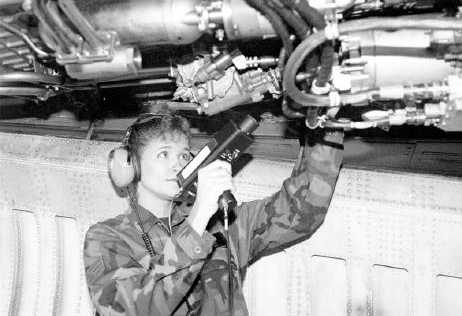T.O. 33B-1-1
5-85
detected 2 feet away, and a leakage rate of 10 std cm3/s can be detected 20 feet away. Larger leakage
rates can be detected at even greater distances. For most cases, 0.1 std cm3/s is the minimum detectable
leakage rate.
c. The ultrasonic leak detector is used also with a contact probe. This probe is placed on the test assembly
and is used to locate internal malfunctions, such as internal bypassing of hydraulic actuators and
leaking valves. Under certain conditions, this probe can also be used for detecting incipient bearing
failures in rotating equipment. However, extensive calibration is required; and this application
(detecting incipient bearing failures) is not generally practical for field use.
d. Typical applications for the ultrasonic leak detector on aircraft systems include locating leaks during
fuel system pressurization tests, locating leaks in bleed air and air conditioning systems, and identifying
internal leaks in hydraulic system.
5.6.2
Equipment.
a. The ultrasonic leak detector consists of the instrument, a set of earphones, two probes, and a rubber
probe extension. The ultrasonic energy detected by the probe is converted into audible signals by the
instrument. These signals are heard by way of a speaker on the face of the instrument or earphones
plugged into the instrument. The earphones are used in noisy locations. The received signals are also
indicated on a meter on the face of the instrument. A volume control on the instrument adjusts the
sensitivity.
b. Complete details on one type of detector including calibration and maintenance procedures are
contained in T.O. 33D9-84-30-1. Technicians should check the maintenance and testing procedures
outlined in the specific technical order/manual for the particular model being used.
5.6.3
Calibration and Testing.
Equipment set up, calibration, and maintenance shall be performed in accordance with the equipment manual. The
following is an example calibration. The calibration and equipment checking procedures given in the following are
intended to be performed by the equipment operator. Figure 5-81 is an example of an inspector doing leak testing.
Figure 5-81. Leak Testing

